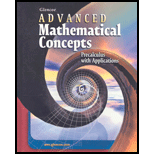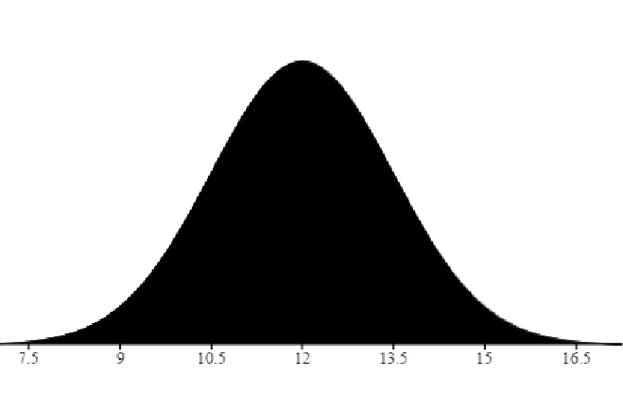
Concept explainers
(a)
To draw:
The graph of a curve that represents the frequency distribution.
(a)
Explanation of Solution
Given:
Standard deviation
Concept used:
Normal distribution: - A normal distribution is a frequency distribution that often occurs
There is a large number of values in a set of data.
The graph of this distribution is a symmetric, bell-shaped curve.
Calculation:
Normally distributed data is
Standard deviation
Draw the graph of the frequency distribution

The frequency and probability distribution are identically shaped for a normally distributed data set.
This graph is bell curve centered at the mean /median /mode and symmetric about this point.
(b)
To find:
The interval about the mean that includes
(b)
Answer to Problem 9E
Explanation of Solution
Given:
Normally distributed data is
Standard deviation
Concept used:
Standard deviation of a set is falls within the interval of
Calculation:
Normally distributed data is
Standard deviation
Using standard deviation in equation (1)
The interval about the mean that includes
(c)
To find:
The data is between
(c)
Answer to Problem 9E
Explanation of Solution
Given:
Normally distributed data is
Standard deviation
Concept used:
Normal distribution: - A normal distribution is a frequency distribution that often occurs
There is a large number of values in a set of data.
The graph of this distribution is a symmetric, bell-shaped curve.
Calculation:
Normally distributed data is
Standard deviation
Each of the limits in terms of the mean
Using the formula
The values lie between
(d)
To find:
The data is between
(d)
Answer to Problem 9E
Explanation of Solution
Given:
Normally distributed data is
Standard deviation
Concept used:
Normal distribution: - A normal distribution is a frequency distribution that often occurs
There is a large number of values in a set of data.
The graph of this distribution is a symmetric, bell-shaped curve.
Calculation:
Normally distributed data is
Standard deviation
Each of the limits in terms of the mean
Using the formula
The values lie between
Chapter 14 Solutions
Advanced Mathematical Concepts: Precalculus with Applications, Student Edition
Additional Math Textbook Solutions
Calculus: Early Transcendentals (3rd Edition)
Thomas' Calculus: Early Transcendentals (14th Edition)
Single Variable Calculus: Early Transcendentals (2nd Edition) - Standalone book
Calculus and Its Applications (11th Edition)
Precalculus (10th Edition)
University Calculus: Early Transcendentals (4th Edition)
 Calculus: Early TranscendentalsCalculusISBN:9781285741550Author:James StewartPublisher:Cengage Learning
Calculus: Early TranscendentalsCalculusISBN:9781285741550Author:James StewartPublisher:Cengage Learning Thomas' Calculus (14th Edition)CalculusISBN:9780134438986Author:Joel R. Hass, Christopher E. Heil, Maurice D. WeirPublisher:PEARSON
Thomas' Calculus (14th Edition)CalculusISBN:9780134438986Author:Joel R. Hass, Christopher E. Heil, Maurice D. WeirPublisher:PEARSON Calculus: Early Transcendentals (3rd Edition)CalculusISBN:9780134763644Author:William L. Briggs, Lyle Cochran, Bernard Gillett, Eric SchulzPublisher:PEARSON
Calculus: Early Transcendentals (3rd Edition)CalculusISBN:9780134763644Author:William L. Briggs, Lyle Cochran, Bernard Gillett, Eric SchulzPublisher:PEARSON Calculus: Early TranscendentalsCalculusISBN:9781319050740Author:Jon Rogawski, Colin Adams, Robert FranzosaPublisher:W. H. Freeman
Calculus: Early TranscendentalsCalculusISBN:9781319050740Author:Jon Rogawski, Colin Adams, Robert FranzosaPublisher:W. H. Freeman
 Calculus: Early Transcendental FunctionsCalculusISBN:9781337552516Author:Ron Larson, Bruce H. EdwardsPublisher:Cengage Learning
Calculus: Early Transcendental FunctionsCalculusISBN:9781337552516Author:Ron Larson, Bruce H. EdwardsPublisher:Cengage Learning





